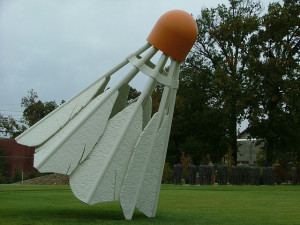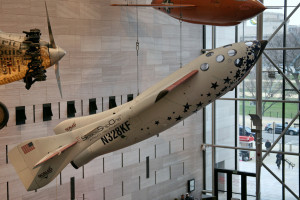
Image by Rebecca Partington via flickr (CC BY-SA 2.0)
The Ansari X-Prize was created in 1996 to spur the development of private space travel. Ten million dollars was offered to the first team capable of designing a re-usable system that could take three people 100 km above the Earth, then return them safely to the ground, and do so twice within a two week period. Rutan’s company Scaled Composites, in collaboration with Microsoft co-founder Paul Allen, developed a vehicle called SpaceShipOne which won the X-Prize in October 2004.
It was not an easy task. There are a number of technical challenges associated with designing a re-usable space craft. Simply launching people safely into space certainly poses a number of problems. But returning those people safely to Earth is equally important and, in some ways, more difficult.
When an object enters the atmosphere at a high velocity, it compresses the air in front of it. The compression causes the air to heat up. The higher the velocity, the higher the temperatures. For example, the outer surface of a NASA Space Shuttle experienced temperatures of roughly 1600°C during re-entry.[1] Such high temperatures can cause the object, such as a meteor, to burn up. Therefore, some sort of thermal protection is required to protect the integrity of a re-entering space craft and its occupants.
One way to provide thermal protection is to use ablative tiles. Essentially, these single-use tiles are specifically designed to burn up during re-entry, dissipate heat, and protect the vehicle. The Apollo capsules relied on ablative shield, as will the Orion spacecraft.[2] The Space Shuttle program, whose goal was to build a re-useable orbital vehicle, adopted a different approach. The shuttles were shielded with re-usable silica tiles which had tremendous thermal properties but poor mechanical ones.
A second challenge when re-entering the atmosphere is ensuring that the spacecraft does so at the proper angle. If the angle is too steep, the re-entry speed will be greater, and the temperatures will be higher. But too shallow an angle can cause the vehicle to “skip” off of the atmosphere like a stone skipping along the surface of the water.
What Rutan recognized in the badminton birdie was a way to address both of these design challenges. He created a vehicle with a movable wing referred to as the “feather.” The feather is oriented much like normal wings during launch. For re-entry, however, the feather is rotated upwards so that it is almost perpendicular to top of the vehicle. This configuration increases the drag on the vehicle, slows its descent, and decreases the thermal loading.[3]But the raised feather is also a configuration with a high degree of stability. Just like a shuttlecock re-orients itself when falling, the vehicle Rutan designed would always return to a particular orientation during descent. Once the vehicle had slowed to subsonic speeds, the feather could be lowered, and SpaceShipOne could be flown and landed just like a glider.
Good engineers and good designers need to be lateral thinkers. They must see connections that others have missed because inspiration might come from anywhere. You never know when a simple insight might solve a significant problem.
You can see SpaceShipOne in action in this YouTube video:
https://www.youtube.com/watch?v=GIUtc9IkdX8
Notes
- ^ John Bluck. “NASA developing new heat shield for Orion.” NASA website. <http://www.nasa.gov/mission_pages/constellation/orion/orionheatshield.html>
- ^ Tanya Nguyen. “Keeping it cool.” NASA website. <http://www.nasa.gov/mission_pages/constellation/orion/heatshield.html>
- ^ “SpaceShipOne and White Knight.” Scaled Composites website. <http://www.scaled.com/projects/tierone/>

